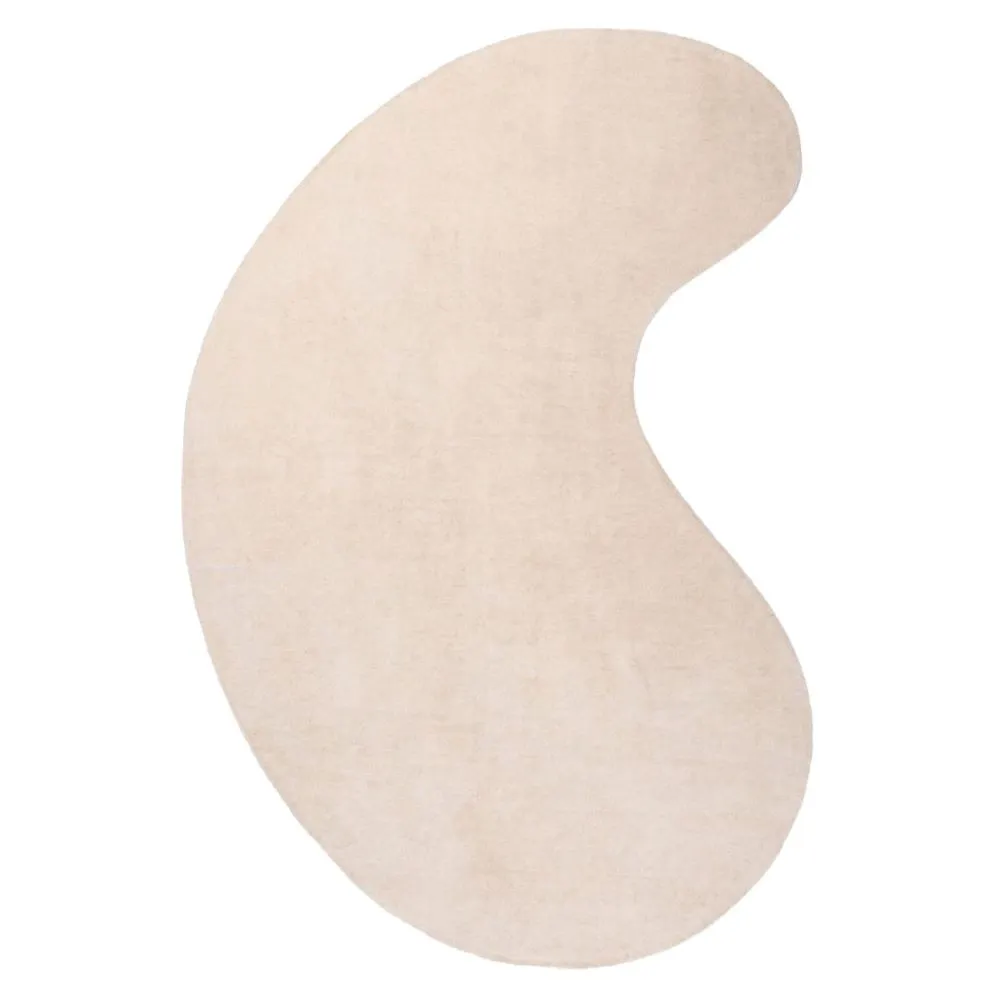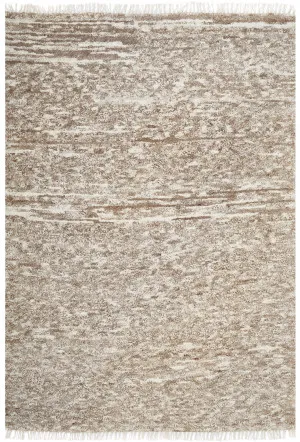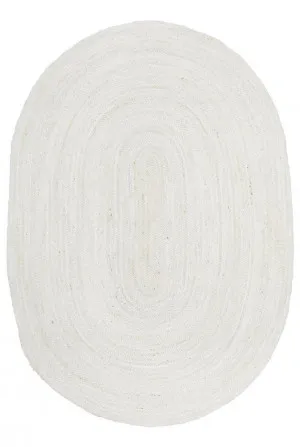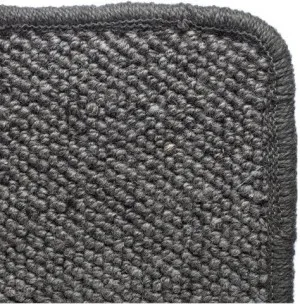Ideas
12 Living Room Rug Ideas That Complete Your Space
Creating a warm, inviting living room goes beyond choosing the right décor, sofa or even lighting. One of the key components of completing your space is a rug. A living room rug can anchor the room, define areas, and add a layer of comfort and texture. And with so many choices available, choosing the right rug can feel overwhelming. So, to help, we’ve put together 12 living room rug ideas that will work to enhance your space, making it feel complete.
Explore our entire product library filled with thousands of different rugs for every living room style and layout.
 Image credit: Alison Lewis Interiors | BuildHer Collective | Dylan James
Image credit: Alison Lewis Interiors | BuildHer Collective | Dylan James
Where Should I Place My Living Room Rug?
Your living room is a versatile space that has so many uses. It’s a place for relaxation, entertainment, and quality time with loved ones. Your living room should reflect your personal style while being welcoming and comfortable. An important element in achieving this balance is the position and location of your living room rug. The placement of your rug significantly impacts the room's overall feel. For a balanced look, the rug should be proportional to the space and furniture, ideally with all the main pieces touching the rug. Our general rule of thumb is to have the legs of your furniture positioned on top of the rug. This not only unifies the space but also creates a visually pleasing area where the eye can comfortably rest.
There's definitely a few exceptions to this rule, so if you’re looking for more tips on how to position your rug, we recommend this guide from Miss Amara.
 Image credit: HAAUS. | Villa Styling
Image credit: HAAUS. | Villa Styling
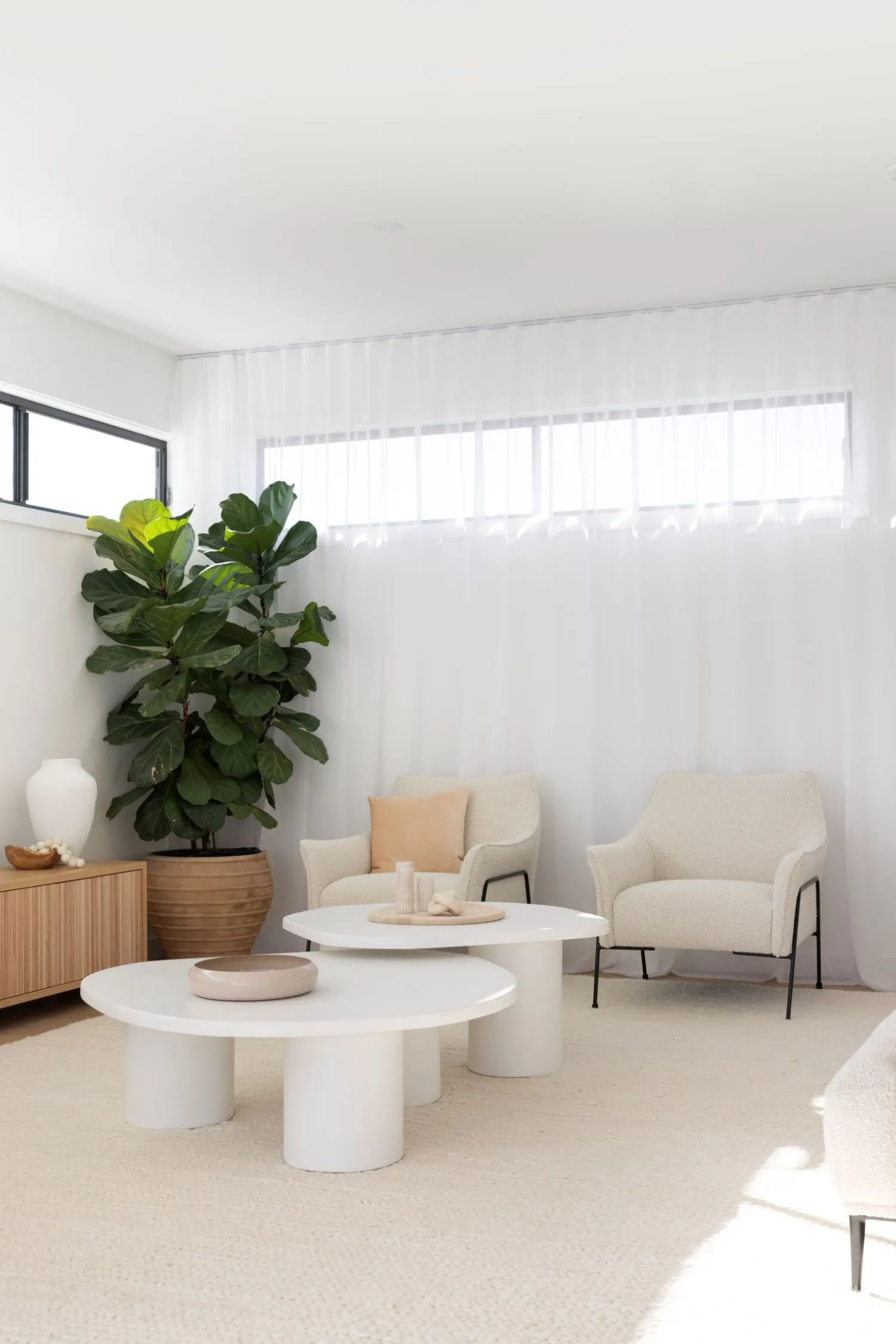 Image credit: HAAUS. | Villa Styling
Image credit: HAAUS. | Villa Styling
1. Rectangle Rugs
Rectangle rugs are the go-to shape for most living rooms due to their versatility in fitting with various furniture layouts. They can easily work to extend the room's proportions, making the space appear larger and more structured. A large rectangle rug can anchor a seating arrangement, while multiple smaller rugs can define different zones within an open-plan space. It’s easy to see why they’re the most popular choice!
Looking for more living room inspiration? Why not check out our Ultra-Chic Armchair Ideas for Your Living Room?
 Image credit: McShane Studio | Anne Stroud Photography
Image credit: McShane Studio | Anne Stroud Photography
2. Round Rugs
Round rugs are a great choice for living rooms with square furniture arrangements, sharp corners, or smaller spaces that would benefit from the soft illusion of curves. They can soften the hard lines of furniture, offering a fluid visual break and making spaces feel more dynamic and inviting. Place a round rug under a circular coffee table to really highlight the space.
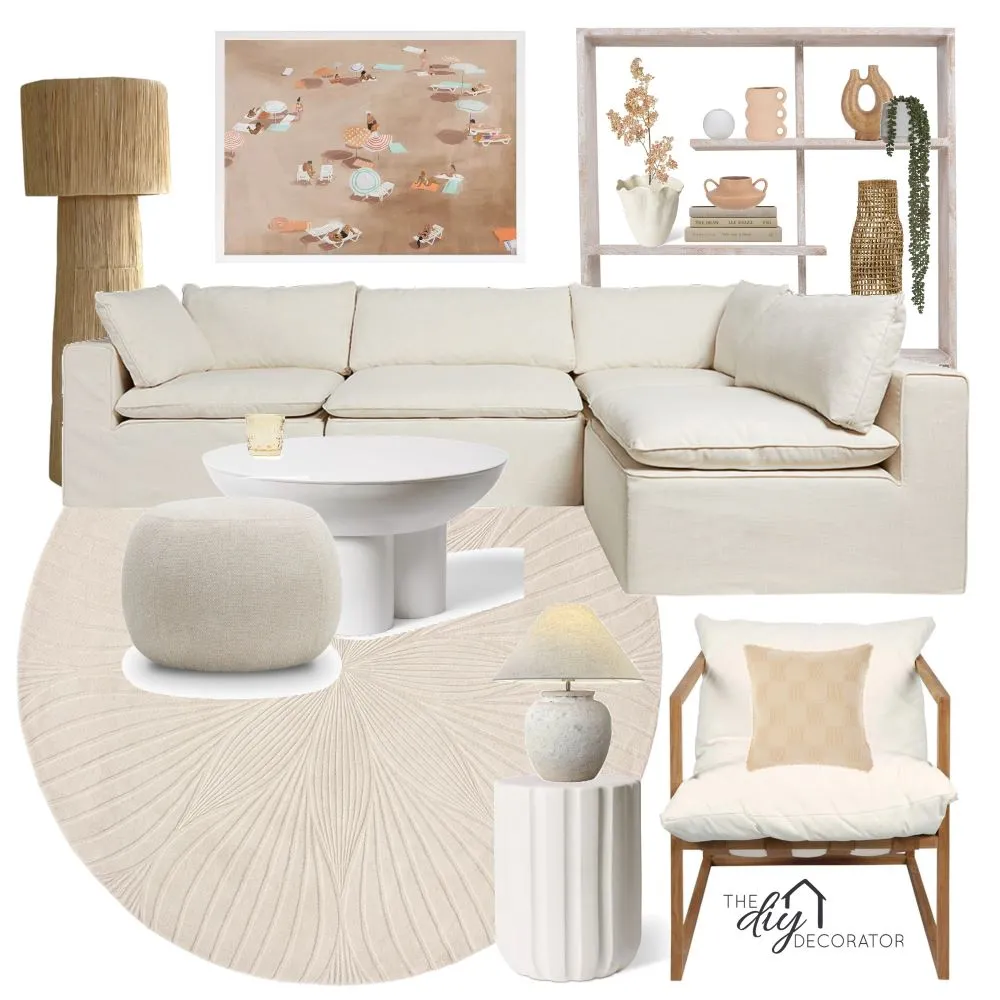 Mood board by The DIY Decorator on Style Sourcebook. Discover the mood board.
Mood board by The DIY Decorator on Style Sourcebook. Discover the mood board.
 Mood board by Kamlehcar on Style Sourcebook. Discover the mood board.
Mood board by Kamlehcar on Style Sourcebook. Discover the mood board.
3. Asymmetric Rugs
Embrace the unexpected with asymmetric rugs, perfect for adding a modern twist to any living space. We’ve seen these rugs rise to popularity lately as they challenge traditional forms, bringing an artistic element and a sense of movement. Ideal for minimalist or contemporary décors, they can become the focal point of the room, around which other elements subtly connect.
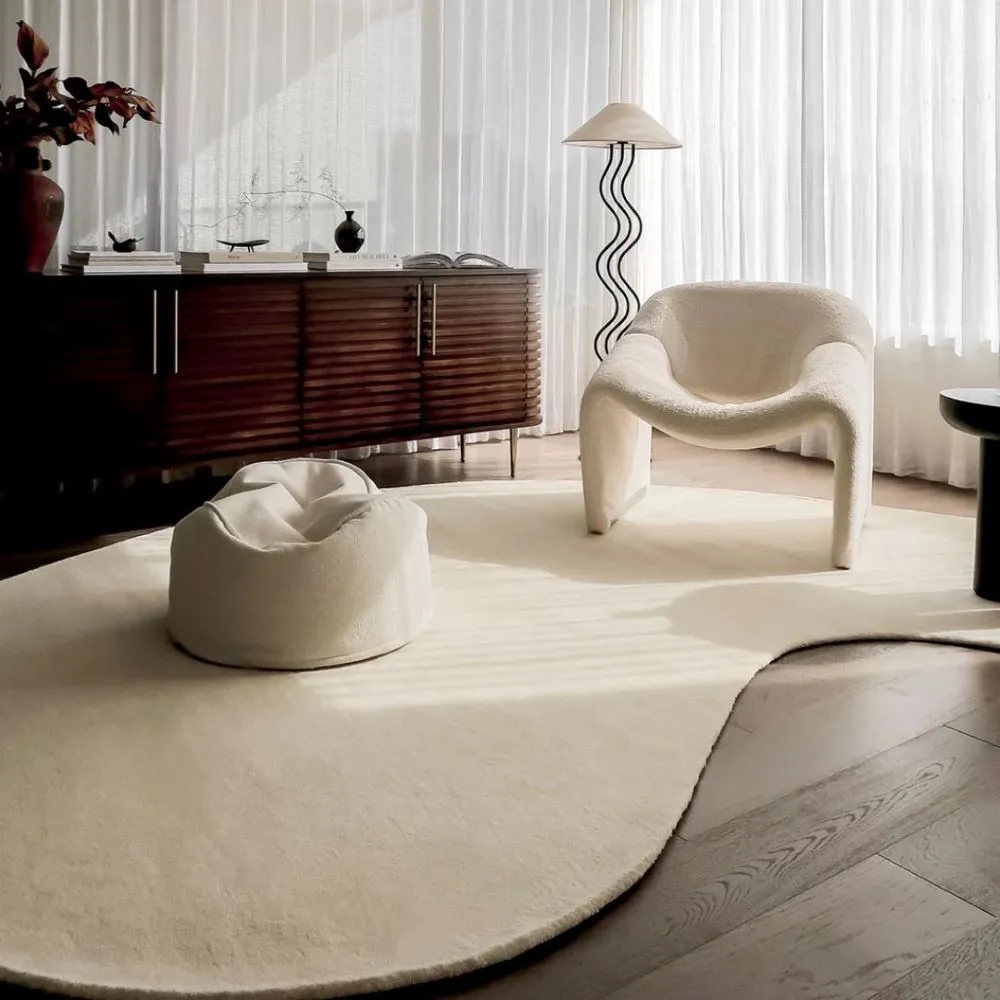 Image credit: Miss Amara | Jem Juthamat
Image credit: Miss Amara | Jem Juthamat
4. White Rugs
While the thought of a white rug might be daunting, its impact is completely undeniable. White rugs can brighten a space, making it appear larger and more luxurious. They demand attention to cleaning and maintenance but reward you with a stunning, sophisticated look that elevates any décor. Pair with darker furniture for a striking contrast or with lighter tones for a minimalist feel.
Tip: If you’re still not convinced about white rugs, why not look into washable options?
 Image credit: HAAUS. | Villa Styling
Image credit: HAAUS. | Villa Styling
5. Darker Rugs
Darker rugs are practical for high-traffic areas and families with children and pets, as they’re great at concealing spills and stains. They ground the living space, adding depth and warmth. Dark hues like green, charcoal, or rich browns can complement a range of colour schemes, from bold and vibrant to understated and neutral.
Check out our Complete Living Room Guide to Coffee Tables.
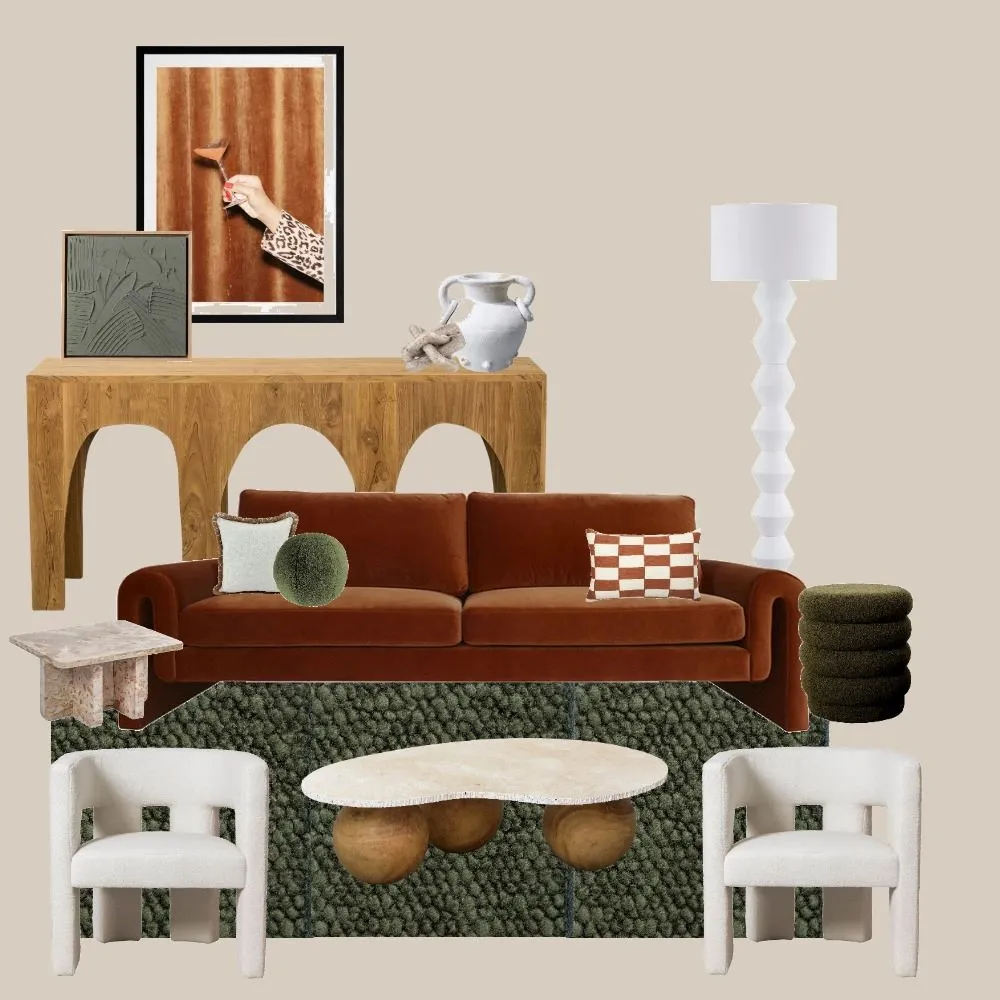 Mood board by Kerrie-Ann Jones Stylist on Style Sourcebook. Discover the mood board.
Mood board by Kerrie-Ann Jones Stylist on Style Sourcebook. Discover the mood board.
 Mood board by Tegan Yates on Style Sourcebook. Discover the mood board.
Mood board by Tegan Yates on Style Sourcebook. Discover the mood board.
6. Neutral Rugs
Neutral rugs are the chameleons of décor, blending seamlessly with any style or colour palette. They provide a subtle texture and warmth, making them the perfect backdrop for more vibrant pieces of furniture or art. Neutral rugs are often utilised as a simple, understated way of adding that extra layer of depth. Think of beige, greys, and soft earth tones that enhance the room's design without overpowering it.
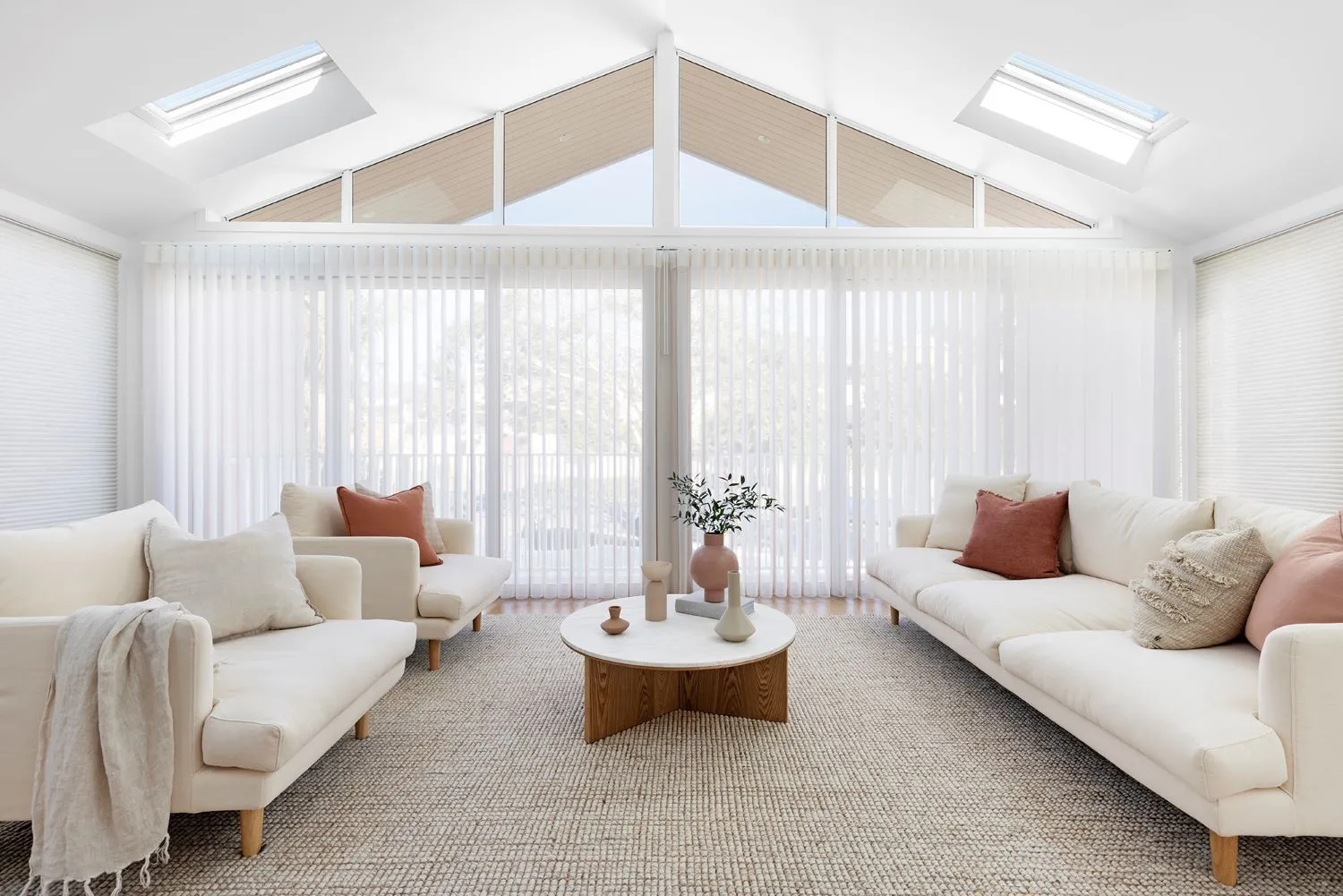 Image credit: Zou Build | Villa Styling
Image credit: Zou Build | Villa Styling
7. Natural Rugs
Incorporate a touch of nature into your living room with rugs made from natural fibres like jute and wool. Not only are they durable and sustainable, but they also add a unique texture and a casual, laid-back vibe. Perfect for creating a cosy, rustic feel, natural rugs are versatile enough to complement both modern and classic interior design styles.
 Image credit: Jessi Eve | Villa Styling
Image credit: Jessi Eve | Villa Styling
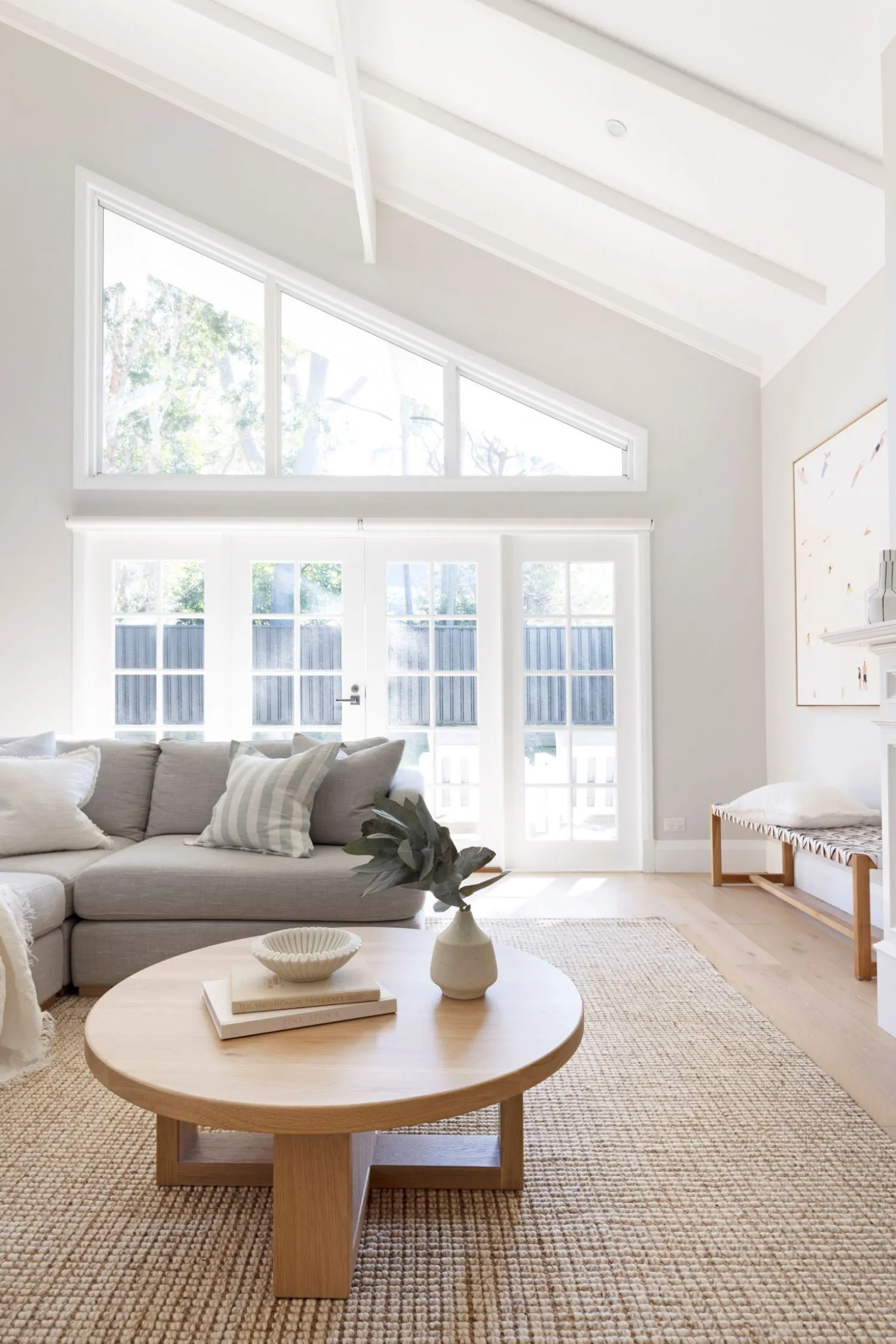 Image credit: Jessi Eve | Villa Styling
Image credit: Jessi Eve | Villa Styling
8. Rug Texture
The texture of your rug can dramatically affect the room's ambiance. Plush, shaggy rugs invite barefoot walks and add a luxurious feel underfoot, while flat-weave or low-pile rugs offer a sleek, easy-to-clean option. Mixing textures can add depth and interest to the room, making it more engaging and comfortable.
 Image credit: SJS Interior Design | Tom Ferguson
Image credit: SJS Interior Design | Tom Ferguson
9. Patterned Rugs
A patterned rug can act as the centrepiece of your living room, injecting colour and personality. From bold geometrics to delicate designs, the patterns can set the tone of the room, serve as a source of colour palette inspiration, or tie together various decorative elements. However, it can be easy to overcrowd your living room with a patterned rug, so our advice is to consider the scale of the pattern in relation to the size of your room and furniture.
 Image credit: Studio Haus Co | Villa Styling
Image credit: Studio Haus Co | Villa Styling
 Image credit: Studio Haus Co | Villa Styling
Image credit: Studio Haus Co | Villa Styling
10. Minimal Rugs
For those who prefer a minimalist aesthetic, a rug with a simple design or in a solid colour can enhance the room's sense of space and serenity. Minimal rugs don't compete for attention, allowing other design elements to stand out. They are perfect for highlighting the beauty of the flooring or complementing a minimalist décor.
 Image credit: @houseonesixtwo | @the.palm.co
Image credit: @houseonesixtwo | @the.palm.co
 Image credit: @houseonesixtwo | @the.palm.co
Image credit: @houseonesixtwo | @the.palm.co
11. Large Rugs
Like white rugs or patterned rugs, a large rug can feel intimidating, but they really can transform your living room, making it feel unified and expansive. Large rugs are an excellent choice for open-plan spaces as they work to create ‘zones’, separating your living room from your dining or kitchen areas without the need for bulky dividers. Our only advice is to ensure the rug is proportional to your living room, allowing all key pieces of your furniture to fit comfortably.
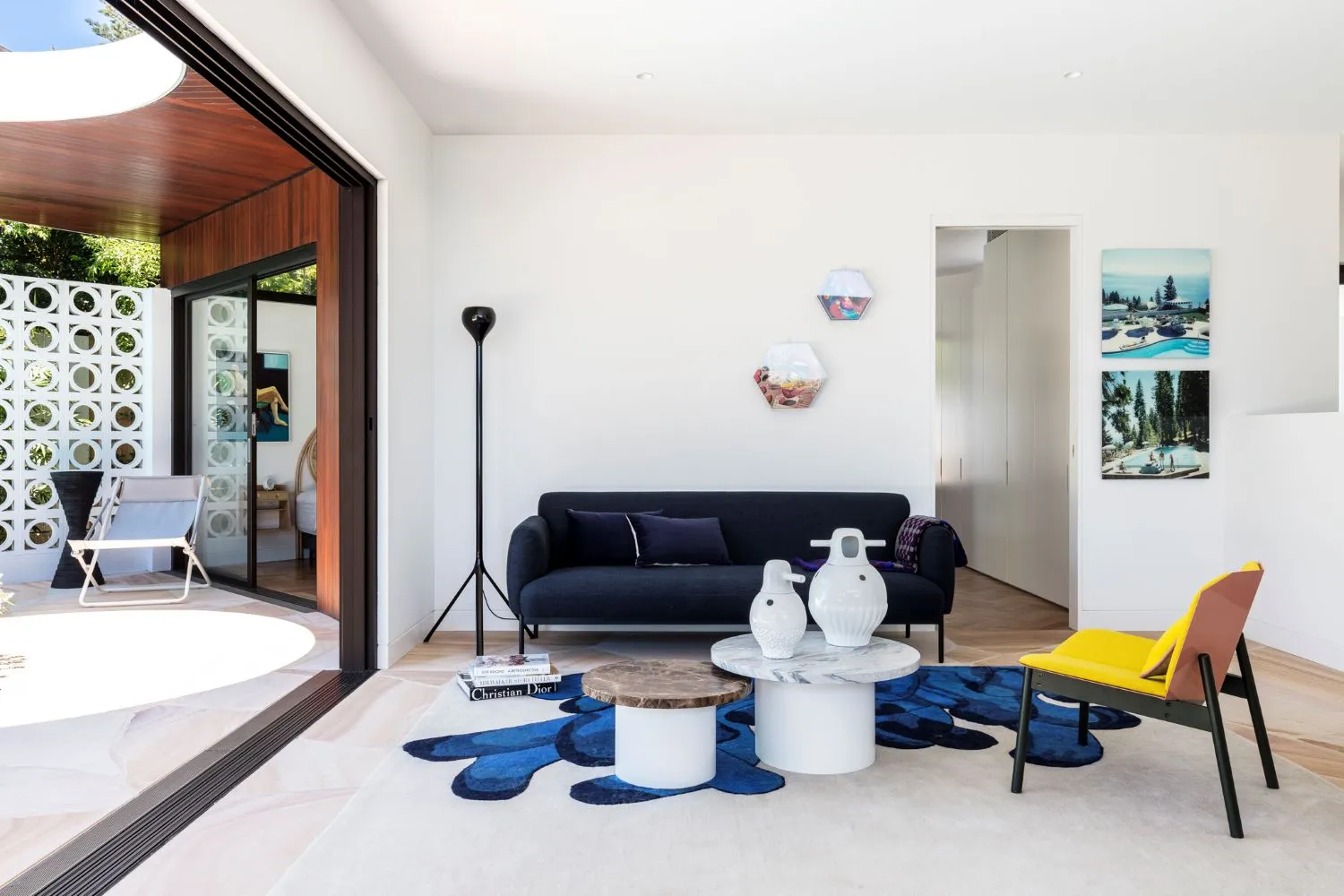 Image credit: Nick Bell Architects | Tom Ferguson Photography
Image credit: Nick Bell Architects | Tom Ferguson Photography
12. Small Rugs
Small rugs can be just as impactful, especially when used to highlight or define specific areas within a larger space. They can add a pop of colour or texture beneath a coffee table, beside a bed, or under a group of chairs, creating intimate seating areas or focal points that draw the eye.
 Image credit: @amastudiointeriors
Image credit: @amastudiointeriors
Selecting the right rug for your living room is about more than just picking a colour or pattern; it's about creating a foundation that enhances every other element in your space. From the shape and size to the texture and design, every aspect of your rug contributes to the overall feel and functionality of your living area. If you’re feeling inspired to bring your living room ideas to life, why not use our mood board tool?
 Image credit: Talm Beach House | Teresa from Muse Photography
Image credit: Talm Beach House | Teresa from Muse Photography
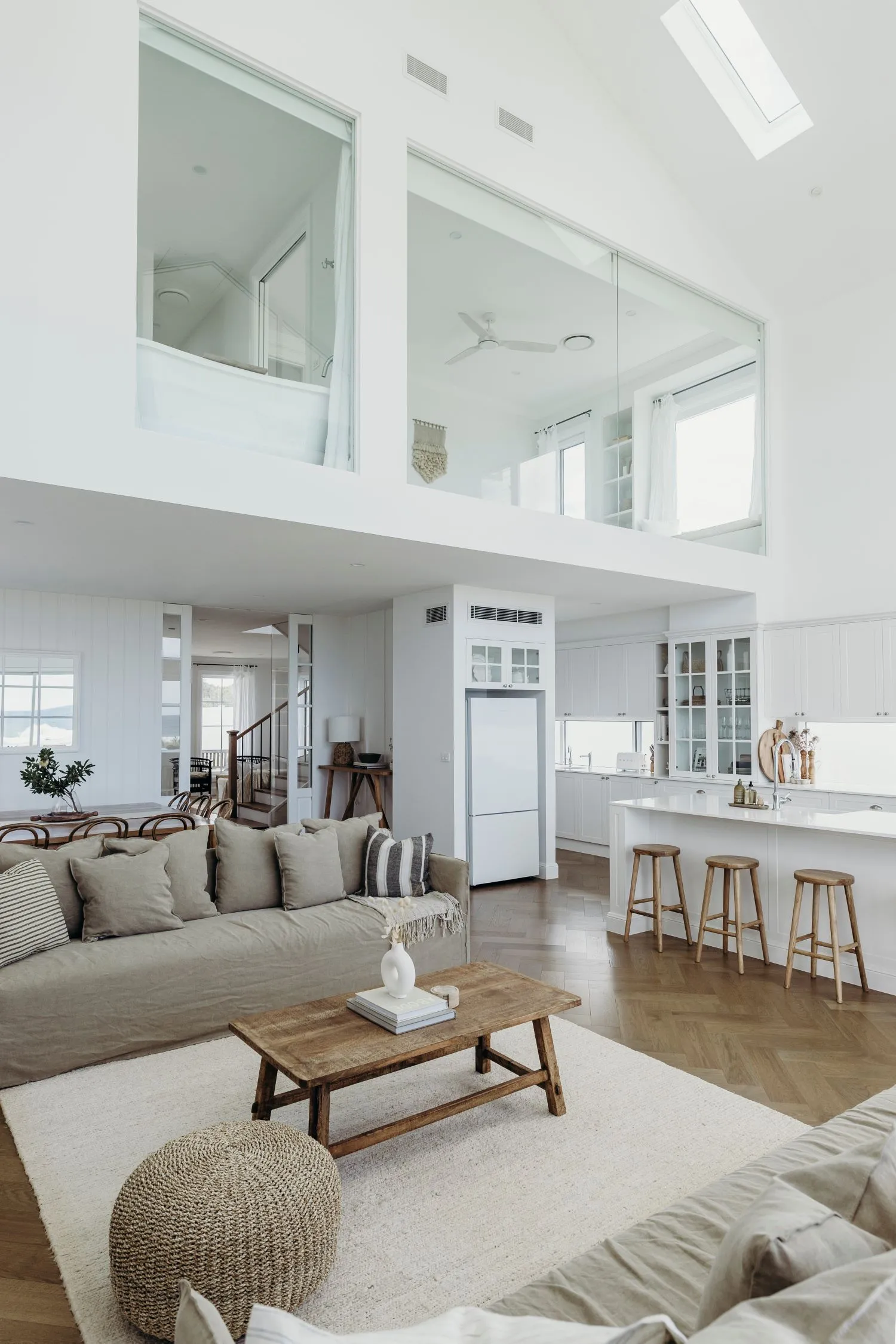 Image credit: Talm Beach House | Teresa from Muse Photography
Image credit: Talm Beach House | Teresa from Muse Photography
Frequently Asked Questions:
What is the best type of rug for a living room?
The best type of living room rug depends on a variety of factors, including your aesthetics, the room’s layout, and your lifestyle. However, natural fibre rugs, such as wool or cotton, are a great choice due to their durability, ease of cleaning, and comfort underfoot. However, if you have children or pets, it might be best to go with a synthetic rug for its stain resistance and durability.
What is the rule on rugs in the living room?
There are a few general rules to consider when placing a rug in a living room. But remember, at the end of the day it really comes down to what works best for you and your space:
Size: Ensure the rug is large enough to fit under the main furniture pieces or at least the front legs of sofas and chairs. This helps to anchor the space and create a cohesive look.
Placement: The rug should be centered in the living room, aligning with the room's focal point, whether it's a fireplace, TV, or another central feature.
Spacing: Leave an equal amount of floor space around the rug to maintain balance. A good rule of thumb is about 10 to 20 inches of bare floor between the edges of the rug and the walls of the room.
Should the living room rug be longer than the couch?
Ideally, the living room rug should be at least as long as the couch, but it doesn't necessarily have to be longer. Having a rug that's the same length or slightly longer than the couch can help to visually extend the seating area, making the space feel more anchored and proportional.
Should a rug be lighter or darker than a couch?
This depends on the desired effect and the room's colour scheme. A rug that is lighter than the couch can help brighten the room and make it appear larger. Conversely, a darker rug can add depth and warmth to the space. Consider the overall design and colour palette of your room. If in doubt, neutral tones can provide flexibility and blend well with most décor.
Should the entryway rug match the living room rug?
While it's not a strict requirement for the entryway rug to match the living room rug, maintaining a cohesive design throughout your home can create a sense of harmony and flow. This doesn't mean they have to be identical, but they should complement each other in style, colour, or pattern. Consistency in material or texture can also help to unify different spaces.

